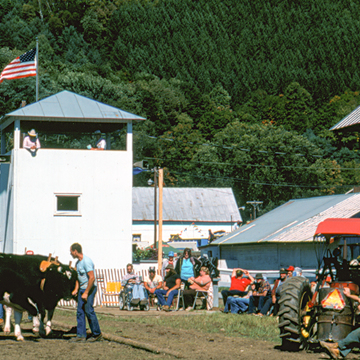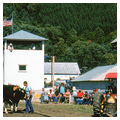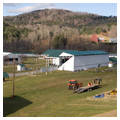In 1843 the Vermont legislature passed an act to encourage the formation of county fair associations by allowing them to award cash prizes to promote “agriculture, domestic manufactures and the mechanic arts.” Unlike earlier fairs, which were of a more social and commercial nature, these newer fairs, organized in all Vermont counties over the next dozen years, promoted agricultural science and technology, and they also became primary annual community celebrations. The Orange County Fair began in 1847, alternating between Chelsea, Bradford, and Tunbridge. After the Civil War, the fair reopened in Tunbridge in 1867, where a speechifying former lieutenant governor called it “a little world's fair,” and the next year the fair began using the phrase on its promotional handbills. It has been known as the “Tunbridge World's Fair” ever since.
The Union Agricultural Society was organized in 1875 and a new fairground developed just below Tunbridge village. Volunteers laid out the grounds, built stock pens, and rolled out the original grass and dirt race track. Floral Hall, built that first year and dedicated to women's arts, is typical of the first-generation buildings. These were generally long, one-and-a-half-story, clapboarded buildings. In the 1890s, as more permanent stock barns and stables were built, many combined the one-and-a-half-story roof pitch of Floral Hall with a simple exterior of horizontal boards and open stall windows with hinged drop-door covers. Good examples of this type are the Ox Barn, between Floral Hall and the river, and the horse stables located between the track and river. After 1900 one-story stock barns with horizontal board or novelty siding became the rule, such as the Jersey and Holstein (and eventually Devon) barns, sponsored by statewide associations as part of their fair competitions. In 1925, the wooden grandstand was rebuilt in its present form with open seating for 1,300 beneath a long, canted-gable roof. A new stage, concessions and bingo hall, machinery hall, public bathrooms, and other buildings have since been added, making the site a showcase of light wood-frame construction in rural Vermont and one of the best-preserved fairgrounds established in the nineteenth-century. Although the fair developed notoriety in the later twentieth century, due mainly to public drunkenness and “girlie” shows, which continued here long after their demise at other county fairs, today the Tunbridge World's Fair has burnished its reputation as one of Vermont's great cultural treasures.


















